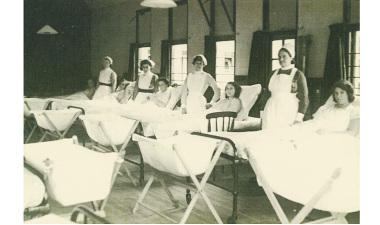Think of a forest, especially at night, and an uneasiness tends to come over you – it might be the fear of getting lost, wild animals, the bogey man. It’s primeval instinct and a horror movie cliché. There’s even a name for it: Nyctohylophobia.
Epping Forest is a sprawling ancient woodland with many legends and folktales attached, but it also has a legacy of providing people with a safe place, of sanctuary and escape.
The Iron-Age Loughton and Ambresbury Camps that I wrote about in a previous blog are believed to be settlements used during times of conflict between neighbouring tribes. Other examples are Londoners who fled to the shelter of the forest during the Great Plague and Great Fire (1665-1666), and Fairmead House in High Beech, a private asylum run by Dr Matthew Allen. Outdoor activities such as working or walking in the forest were among the methods used to treat some of his patients, including the poet John Clare during the mid 1800s.
Maternity Ward in High Beech, Epping Forest during WWII
The building that now stands on the asylum plot has always been called Suntrap, and was erected in 1894 for Harold Baring (of the Barings Bank family). It is now a forest education centre for London school kids, which I attended with great excitement during the 1980s. But it was originally a convalescent home for children from the East End with TB, and then during World War II Plaistow hospital moved its maternity ward to High Beech so that East End mothers could give birth in peace and safety. They would travel up a few days before their due date and camp outside until a bed was free. Many families were made homeless or feared for their lives. Some camped in Epping Forest to escape the intensity of bombing on London during the Blitz.
Bomb pond at Fairmead, Epping Forest
The impact of WWII on the forest is still visible today. There are barrage balloon tethers on Wanstead Flats and concrete floors of Nissen huts in High Beech, which housed German and Italian prisoners of war. Although many of the 100 ponds in Epping Forest are gravel pits or ornamental ponds, some are craters formed by V2 bombs. There’s a number of bomb ponds between Fairmead Road (now a forest pathway) and Epping New Road.
Epping Forest hasn’t been an entirely natural landscape since Neolithic times; we’ve created wood pastures and grazed our livestock, built settlements, made a royal forest for hunting, and left the scars of fallen bombs. Whether we tend or destroy, we have been shaping it for centuries.
Interactive map of where bombs fell on London during the Blitz.


